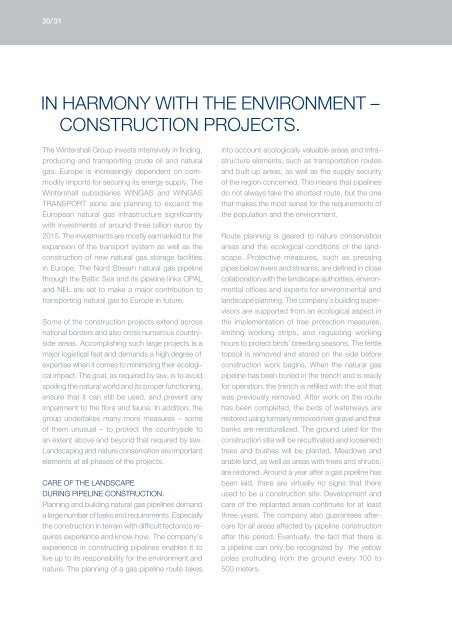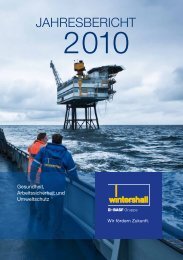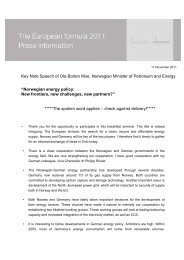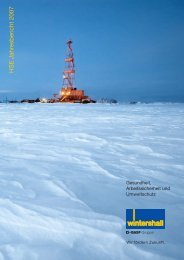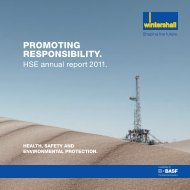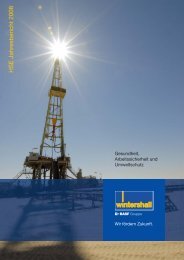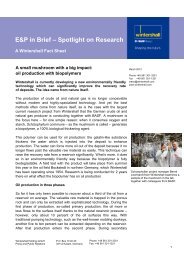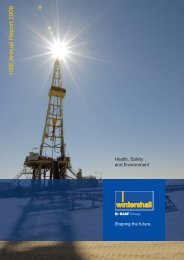HSE Annual Report 2010 (English) - WINTERSHALL
HSE Annual Report 2010 (English) - WINTERSHALL
HSE Annual Report 2010 (English) - WINTERSHALL
You also want an ePaper? Increase the reach of your titles
YUMPU automatically turns print PDFs into web optimized ePapers that Google loves.
30/31<br />
IN HARMONY WITH THE ENvIRONMENT –<br />
CONSTRUCTION PROjECTS.<br />
The Wintershall Group invests intensively in finding,<br />
producing and transporting crude oil and natural<br />
gas. Europe is increasingly dependent on commodity<br />
imports for securing its energy supply. The<br />
Wintershall subsidiaries WINGAS and WINGAS<br />
TRANSPORT alone are planning to expand the<br />
European natural gas infrastructure significantly<br />
with investments of around three billion euros by<br />
2015. The investments are mostly earmarked for the<br />
expansion of the transport system as well as the<br />
construction of new natural gas storage facilities<br />
in Europe. The Nord Stream natural gas pipeline<br />
through the Baltic Sea and its pipeline links OPAL<br />
and NEL are set to make a major contribution to<br />
transporting natural gas to Europe in future.<br />
Some of the construction projects extend across<br />
national borders and also cross numerous countryside<br />
areas. Accomplishing such large projects is a<br />
major logistical feat and demands a high degree of<br />
expertise when it comes to minimizing their ecological<br />
impact. The goal, as required by law, is to avoid<br />
spoiling the natural world and its proper functioning,<br />
ensure that it can still be used, and prevent any<br />
impairment to the flora and fauna. In addition, the<br />
group undertakes many more measures – some<br />
of them unusual – to protect the countryside to<br />
an extent above and beyond that required by law.<br />
Landscaping and nature conservation are important<br />
elements at all phases of the projects.<br />
CARE OF THE LANDSCAPE<br />
DURING PIPELINE CONSTRUCTION.<br />
Planning and building natural gas pipelines demand<br />
a large number of tasks and requirements. Especially<br />
the construction in terrain with difficult tectonics requires<br />
experience and know-how. The company’s<br />
experience in constructing pipelines enables it to<br />
live up to its responsibility for the environment and<br />
nature. The planning of a gas pipeline route takes<br />
into account ecologically valuable areas and infrastructure<br />
elements, such as transportation routes<br />
and built-up areas, as well as the supply security<br />
of the region concerned. This means that pipelines<br />
do not always take the shortest route, but the one<br />
that makes the most sense for the requirements of<br />
the population and the environment.<br />
Route planning is geared to nature conservation<br />
areas and the ecological conditions of the landscape.<br />
Protective measures, such as pressing<br />
pipes below rivers and streams, are defined in close<br />
collaboration with the landscape authorities, environmental<br />
offices and experts for environmental and<br />
landscape planning. The company’s building supervisors<br />
are supported from an ecological aspect in<br />
the implementation of tree protection measures,<br />
limiting working strips, and regulating working<br />
hours to protect birds’ breeding seasons. The fertile<br />
topsoil is removed and stored on the side before<br />
construction work begins. When the natural gas<br />
pipeline has been buried in the trench and is ready<br />
for operation, the trench is refilled with the soil that<br />
was previously removed. After work on the route<br />
has been completed, the beds of waterways are<br />
restored using formerly removed river gravel and their<br />
banks are renaturalized. The ground used for the<br />
construction site will be recultivated and loosened;<br />
trees and bushes will be planted. Meadows and<br />
arable land, as well as areas with trees and shrubs,<br />
are restored. Around a year after a gas pipeline has<br />
been laid, there are virtually no signs that there<br />
used to be a construction site. Development and<br />
care of the replanted areas continues for at least<br />
three years. The company also guarantees aftercare<br />
for all areas affected by pipeline construction<br />
after this period. Eventually, the fact that there is<br />
a pipeline can only be recognized by the yellow<br />
poles protruding from the ground every 100 to<br />
500 meters.


